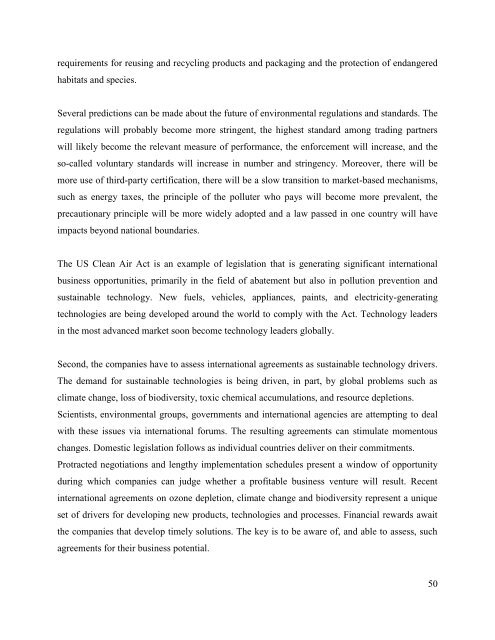ISM AND ISEG MBA - Développement durable
ISM AND ISEG MBA - Développement durable
ISM AND ISEG MBA - Développement durable
You also want an ePaper? Increase the reach of your titles
YUMPU automatically turns print PDFs into web optimized ePapers that Google loves.
equirements for reusing and recycling products and packaging and the protection of endangered<br />
habitats and species.<br />
Several predictions can be made about the future of environmental regulations and standards. The<br />
regulations will probably become more stringent, the highest standard among trading partners<br />
will likely become the relevant measure of performance, the enforcement will increase, and the<br />
so-called voluntary standards will increase in number and stringency. Moreover, there will be<br />
more use of third-party certification, there will be a slow transition to market-based mechanisms,<br />
such as energy taxes, the principle of the polluter who pays will become more prevalent, the<br />
precautionary principle will be more widely adopted and a law passed in one country will have<br />
impacts beyond national boundaries.<br />
The US Clean Air Act is an example of legislation that is generating significant international<br />
business opportunities, primarily in the field of abatement but also in pollution prevention and<br />
sustainable technology. New fuels, vehicles, appliances, paints, and electricity-generating<br />
technologies are being developed around the world to comply with the Act. Technology leaders<br />
in the most advanced market soon become technology leaders globally.<br />
Second, the companies have to assess international agreements as sustainable technology drivers.<br />
The demand for sustainable technologies is being driven, in part, by global problems such as<br />
climate change, loss of biodiversity, toxic chemical accumulations, and resource depletions.<br />
Scientists, environmental groups, governments and international agencies are attempting to deal<br />
with these issues via international forums. The resulting agreements can stimulate momentous<br />
changes. Domestic legislation follows as individual countries deliver on their commitments.<br />
Protracted negotiations and lengthy implementation schedules present a window of opportunity<br />
during which companies can judge whether a profitable business venture will result. Recent<br />
international agreements on ozone depletion, climate change and biodiversity represent a unique<br />
set of drivers for developing new products, technologies and processes. Financial rewards await<br />
the companies that develop timely solutions. The key is to be aware of, and able to assess, such<br />
agreements for their business potential.<br />
50


